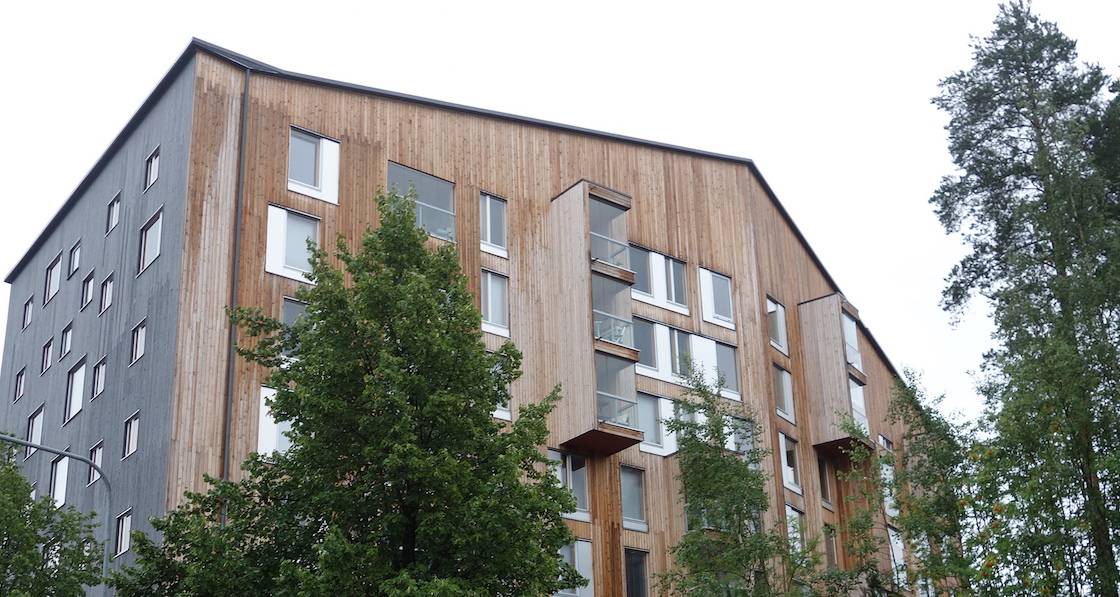
- Blogs
- Posted
Reflections on sustainable Nordic architecture
It’s no coincidence that Nordic countries are some of the most advanced in the world when it comes to low energy design. In this article, three assistant professors of architecture based in Denmark and Finland discuss areas where we can learn from our Nordic neighbours — and where we might return the favour.
By Sofie Pelsmakers (Tampere University), Urszula Kozminska & Elizabeth Donovan (Aarhus School of Architecture)
To meet climate change mitigation targets, higher performing building fabric standards are enforced across Europe. Base principles are set out in the EU’s Energy Performance of Buildings Directive, requiring all new buildings to be nearly zero energy buildings (NZEB) from 2020 (and where publicly funded, since 2019). In response, building industry professionals have included new materials and innovative products, construction methods, energy production and supply systems as part of building design. This was particularly the case in the UK, where the (since abandoned) zero carbon definition emphasised on-site energy production, encouraging the use of additional or innovative technologies and active engineering systems.
While this has led to technological innovations, a downside is that it has generally led to technological ‘add-on’ solutions in favour of further improved fabric energy efficiencies. In other cases, it has also led to greenwash or to buildings that overly rely on active systems, to the detriment of usability and building performance. Despite the increased focus on reduced operational energy use and associated CO2 emissions (and, more recently, embodied carbon reductions), it can be argued that the construction industry as a whole has been slow to respond to environmental and climatic challenges, often leading to buildings that lack environmental ambition and imagination. More often than not spatial and aesthetic qualities and non-energy related issues are de-prioritised, alienating many in the architectural design profession, and some clients and the public (1,2).
As a contrast to these prevailing scenarios, many buildings in the Nordic region quietly respond to society’s climatic and environmental challenges (3). Moreover, the human-centred approach to the design process has been predominant in several sustainable Nordic projects (4), though not all. That is not to say that all new Nordic architecture is inherently sustainable, or that they all avoid ‘bolt-on’ technologies at the expense of other humanistic qualities. However, the Nordic region has a long tradition of carefully crafting spaces to celebrate light and retaining warmth, in response to the harshness of the local climate, such as cold winters, and diminished daylighting during the long Nordic winters, while also celebrating the long, light summer days.
Earlier modernist examples were often inspired by the characteristics of a particular place, such as light, topography, materials, construction methods, history, nature etc. This traditional Nordic contextual, regional and humanistic focus is still at the heart of many contemporary architecture projects, leading to place-and society-specific approaches, often reimagining vernacular traditions and craftsmanship.
In Finland, where average winter temperatures in Helsinki are about -4C, and can drop to below -25C for periods, current urban housing design standards are similar to the passive house standard (5). Even in milder Denmark (average winter temperatures of about 1C), design standards for housing are also moving towards the passive house standard, while minimum daylighting provision is also legislated for (6). In Norway, the NZEB standard is comparable with the passive house standard but is measured in CO2 equivalent instead of primary energy. Responding to these harsh climates to keep people warm has been a primary driver of building design. This has also meant that further consideration of building energy use issues, good building envelope design and detailing has been more integrated and accepted as established practices in Nordic design and construction traditions for quite some time.
In addition to a focus on energy and thermal comfort, architects are increasingly involved with user engagement (for instance see Vandkunsten’s Lisbjerg Hill), CLT prefabrication methods, and do not tend to neglect spatial quality in favour of good energy performance. It is this capacity for a more holistic approach to sustainability and a more diverse approach to sustainable design that is valued. However, Nordic architecture can often still fall short in checking that what was designed also works and meets expectations (in other words, post-occupancy evaluations and building performance monitoring).
Feedback processes are even less present than in the UK, though this is slowly changing as the value in going back to projects is becoming apparent (7,8). In addition, there is a big potential for knowledge sharing within and outside the region, as well as futureproofing and adaptation for climate change issues such as flood-related risks and increased summer temperatures. This is where the Nordic region is looking to other regions’ approaches, yet so much can be learned from them too.
References
1. Di Carlo Ilaria, 'The aesthetics of sustainability', List - Laboratorio Internazionale Editoriale Sas, Rovoreto, Italy, 2016
2. Frampton Kenneth, 'Urbanization and discontents: Megastructure and Sustainability', in 'Aesthetics of sustainable architecture', (Lee Sang), 010 Publishers, Rotterdam, Netherlands, 2011, pp.97-108
3. Sokol, D., 'Nordic Architects - Ebbs And Flows', Arvinius Forlag. Stockholm, Sweden, 2013
4. Nielsen R., 'Good buildings on a small planet', Arvinius and Orfeus Publishers, 2017
5. Ministry of the Environment, Energy efficiency of buildings, and Finland’s national plan to increase the number of nearly zero-energy buildings
6. Malkawi, A., Nygaard, M., Beim, A., Stenberg, E., 'Sustainability in Scandinavia: Architectural Design and Planning', Edition Axel Menges, Stuttgart/London, 2018
7. Architects Council of Europe, 'The architecture Profession in Europe 2016- a sector study', https://www.ace-cae.eu/activities/publications/sector-study-2016/
8. Pelsmakers, S., Hilberth, T., 'Feedback in architecture: what does it mean, and why do it?', S-arch conference, Havana, Cuba, March 2019




